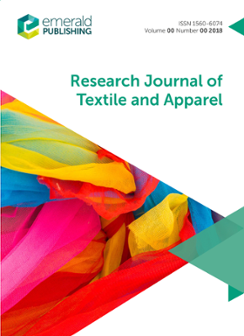Table of contents
Digital Ink-jet Printing on Textiles
C.W. Kan, C.W.M. YuenDigital ink-jet printing was developed more than two decades ago, to print image directly from the computer on substrates such as paper, film and plastic, etc. In the past decade…
Eco-Friendly Natural Dyes: A Comparative Study with Direct Dyes
M.P. Sathianarayanan, Bhat NarendraWith an increasing awareness of environmental pollution and health hazards associated with synthesis, processing and use of synthetic dyes, there is a worldwide interest in…
INatural Blue Dye from Clitoria Ternatea: Extraction and Analysis Methods
Keka Sinha, Papita Das (Saha), Siddhartha DattaAn increased environmental awareness of health hazards caused by synthetic dyes has led to revival of natural dyes. Dyes obtained from natural sources have emerged as important…
Optimization of Process Parameters for Coloration & Antibacterial Finishing of Silk Fabrics Using Natural Fungal Extract
Parthiban Manickam, Thilagavathi GovindarajanThis study aims to evaluate and optimize the dyeing potential of fungal pigments for silk fabrics. The fungal pigments were extracted from thermomyces, purified and characterized…
Natural Flame Retardant Finish for Textiles
Ruma Chakrabarti, P.C. ShobhanashreeThe field of flame retardancy has witnessed rigorous development in the area of new technologies, products and materials to meet the challenge and needs of ever changing safety…
Antibacterial Properties of Natural Dyes on Cotton Fabrics
Anjali Karolia, Umang KhaitanGarment functionality has become a major area of concern to the consumer. The study aimed to evaluate the antibacterial activity of five natural dyes- neem leaves, turmeric, tea…
Influence of UV Radiation on Extraction and Dyeing of Cotton Fabrics Using Eucalyptus Bark Powder as Natural Dye
Ijaz A. Bhatti, Shahid Adeel, Safia Rani, Tahsin Gulzar, Saima Naz, H.F. MansourThe efficiency of UV radiation on boiled aqueous and alkaline extracts of Eucalyptus bark powder has been determined. Irradiated and un-irradiated cotton fabrics were used to…
Multifinishing of Cotton Fabrics Using Microwave Techniques
Ali Hebeish, Samar Sharaf, Rakia Refaie, Amira El ShafeiAn alternative approach is used to cure glyoxal/β-cyclodextrin treated cotton fabric to impart a crease resistance finish. Low microwave power (200 w) for 2 min of curing time is…
Visual Effects of Stainless Steel and Retro-Reflective Yarns on Woven Fabrics
Nesrin Önlü, Havva HalaçeliIn the 1970s, rapid developments and changing technology enabled the transition from an industrial to an information society to speed up, meanwhile causing cybernetic, biomimetics…
Optimisation of Extraction and Dyeing Processes of Parmilia Usnea - Approach to Sustainable Craft Practise in Garhwal Himalayas
Nidhi L. Sharda, Deepali RastogiThis paper examines the commercial viability of Parmelia usnea in small-scale dyeing units of Garhwal Himalayas and the traditional craft of the region. Physicochemical analysis…
Dual Functionalisation of Cotton Fabrics by Using Punica Granatum Rind Extract
C. Balakumar, R. Rajendran, J. Kalaivani, R. SivakumarIn the present study, cotton fabrics are dyed with extracts obtained from the rinds of the pomegranate fruit, Punica (P.) granatum. The fabrics are then assessed for…
Investigating the Impact of Enzymatic Treatment on Mechanical and Chemical Properties of Denim Fabrics
S.M. Saleh, Ihab El-Sayed, Ahmed El-ShikhThis study examines the effects of enzymatic treatment by acid and neutral cellulases after desizing and washing denim fabric. Tensile strength, elongation, stiffness, crease…

ISSN:
1560-6074Online date, start – end:
1997Copyright Holder:
Emerald Publishing LimitedOpen Access:
hybridEditor:
- Prof Gail Taylor